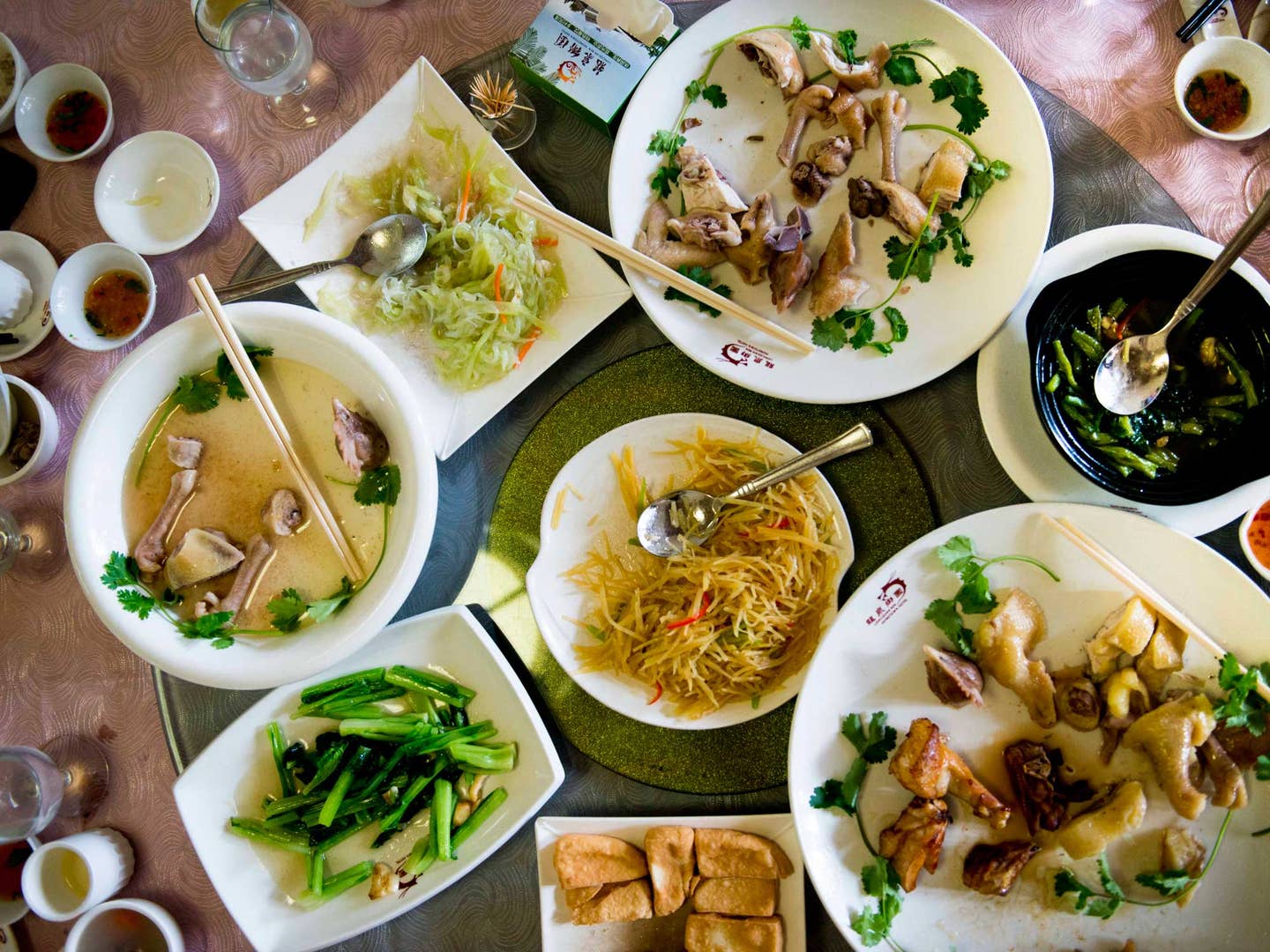
The World’s Best Chicken Comes From Hainan
Across Southeast Asia, Hainan chicken rice is the obsessed-over, gold standard of the bird; Kevin Pang heads to the source to investigate just what makes it so good
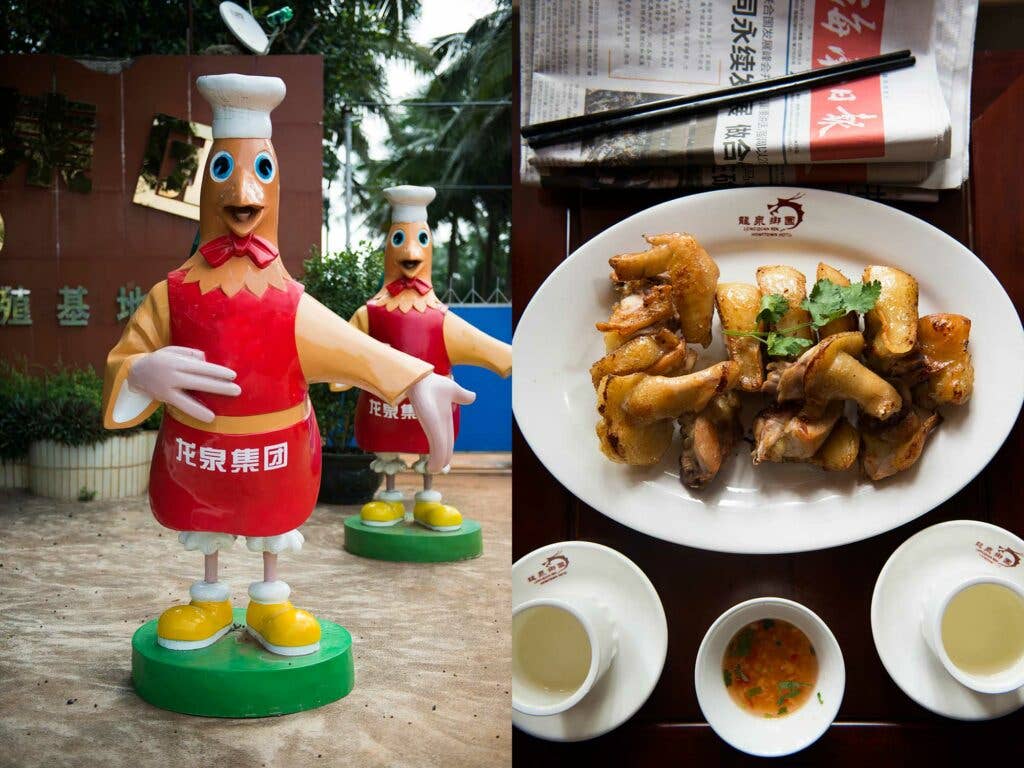
An old traveler's adage: The more ramshackle the restaurant, the more soulful and satisfying the food find. So here I am at a spot in Wenchang, China, perched along the canal and facing Three Corners Street, with rickety tables, pink plastic lawn chairs, and tarps strung overhead that shade from the fierce sun. Several older men in flip-flops just sit here, for no reason other than it's midafternoon on Hainan Island, and the air is so sweltering and sticky the smart thing is to remain motionless until sundown.
This restaurant specializes in Wenchang chicken, the hometown specialty, and it is called, fittingly, Wenchang Chicken Restaurant. The 63-year-old owner, Sung Shen Mei, tells me it has operated continuously here since 1927. His grandparents, he says, were the first to make a living serving the dish.
When I ask to watch Sung cook, he brings me to a tight, greasy closet of a kitchen with a wood-burning stove heating a wok of simmering broth. Half an hour earlier, he'd rubbed the chicken's cavities with salt and ginger and lowered them into the broth, beige from dozens of bird baths before it. Now, Sung uses two-foot-long wooden dowels to fish out the whole, head-on specimens, and they emerge glistening from comb to claw.
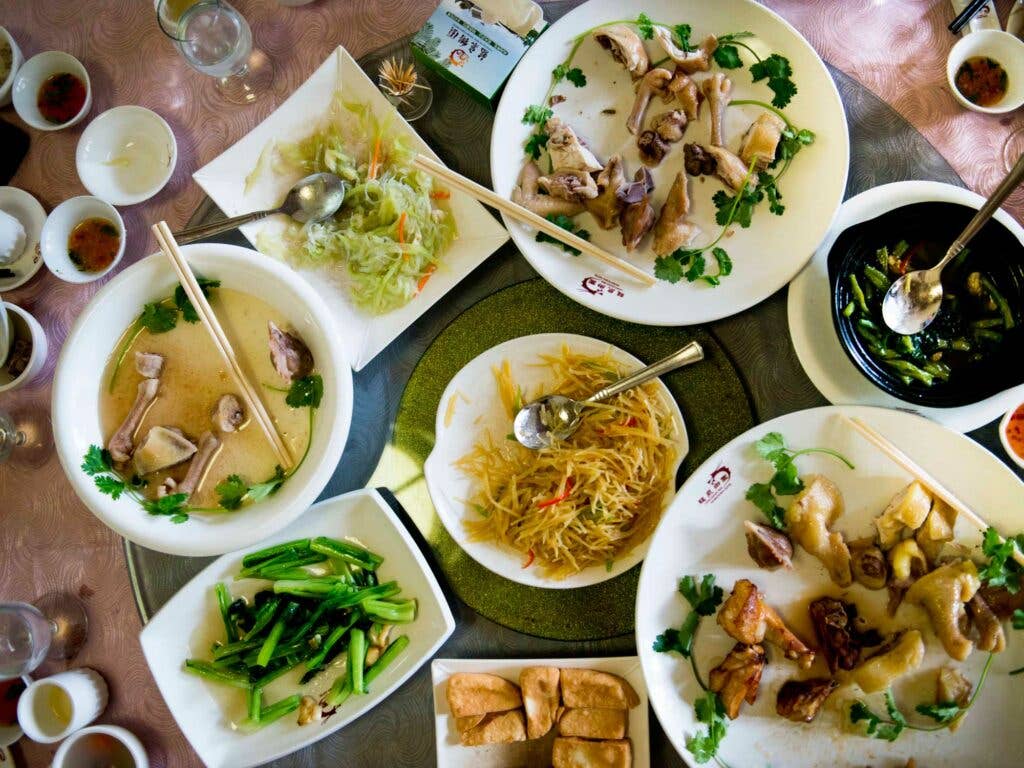
Next up: a glass-enclosed alcove by the front of the restaurant, open at the top, where a medieval-looking cleaver sits on a wooden board that has been chopped concave. There's noise from all directions—incessant honks of three-wheeled motorcycles, fireworks crackling in some nearby alley—and under it all the alluring whack-whack-whack of the meat cleaver, a Chinese Pavlovian trigger if there ever were one. In 30 seconds, Sung breaks down the chicken into two-bite segments, then arranges them on a plate with rubbery blood cakes and chopped gizzards. He carries it to a table on the sidewalk outside the restaurant, along with a tray of chopped ginger, garlic, red chile, sesame oil, and the orange-green citrus fruit calamansi (tasting like a cross between a lime and a kumquat), which he combines into a tart, savory, tingly dipping sauce. The mixture is classically Chinese except for the calamansi juice, which stands in for vinegar, an island twist. The recipe hasn't changed at Sung's place in 90 years.
This, before me, is Wenchang chicken, the progenitor of one of the most beloved culinary exports of Southeast Asia: Hainan chicken rice.
In Singapore, Malaysia, and other Southeast Asian countries, Hainan chicken rice has achieved last-meal cult status, and the dish is known for the clean taste and relative simplicity of its components—poached chicken alongside a bowl of chicken-fat-slicked rice and cool dipping sauce. When I was growing up in Hong Kong, this was my hands-down favorite meal. And why not? It was unfussy, it was homey, it was skin-on chicken.
For many years after I'd moved to the United States, true Hainan chicken rice eluded me. Even in cities with robust Chinatowns, the versions available were inferior to the ones at home. But recently, I'd seen Hainan chicken rice beginning to gain traction stateside. Each time I'd come across a version at a neighborhood restaurant or in the press, I would yearn for a proper plate of my childhood favorite. The solution? To hunt down the original version and eat it where it was born rather than where it spent its formative years.
Standing in that thick midafternoon air outside Sung's ramshackle restaurant, I aim my chopsticks for a thigh piece, naturally: It's the tastiest quadrant of a chicken. What I taste first is that blond chicken skin. It's plump and fatty as lips. There's a luscious, gelatinous quality, and the flavor of chicken oil leaching from it is as indulgent as the fat cap of a rib-eye steak. Then I notice the meat—toothsome, gamy, and flavorful like wild turkey or pheasant, but after I dip some into the sauce and chew for a bit, a sweetness comes to the forefront. It occurs to me that what it really tastes like is an exaggerated form of chicken, both delicious and jarring. It brings to mind the apotheosis of other foods: the buttery, marbled beef of Kobe, the fruity, peppery olive oil of Liguria.
This Wenchang chicken experience feels unmistakably Chinese, looks Chinese, and Sung is hovering over me seeking validation in Chinese small talk. Yet, something about this chicken feels miles away from the China I know.
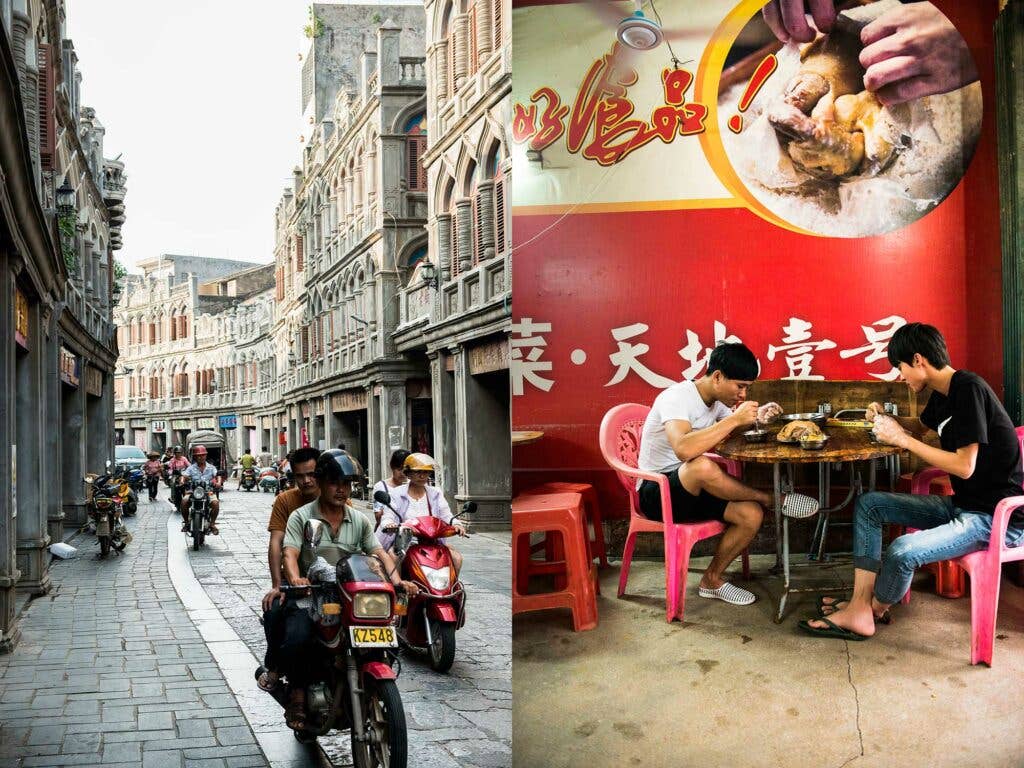
Pagodas, the Great Wall, modern skyscrapers, smog-filled metropolises: That's China. But on Hainan, as far south as you can stand on People's Republic soil, your mind's imagery of China requires a certain recalibration. This is China operating at a slower pace, where fresh juice from just-hacked-open young coconuts is sold street-side for less than a cup of tea. The food is colored by ingredients that are tropical in nature—pineapples, mangoes, rambutans, that calamansi. You don't normally associate China with coffee plantations, but they grow beans here and drink their brew alongside chewy coconut rice cakes. While air pollution on the mainland is so hazardous that face masks are considered fashion accessories, Hainan's capital city, Haikou, enjoys the cleanest air readings in China. The seaside resort of Sanya sits on the south end of the island, where in recent years the Chinese government invested billions of dollars hoping to turn it into “the Hawaii of Asia.” But outside Sanya, in towns like Wenchang, little tourism infrastructure exists. It's a place where roadside dog restaurants operate openly, the type of business the government might sweep under the rug if more Western guidebooks steered tourists here.
Still, Wenchang occupies an important place in the diaspora of Southeast Asian food. Many of the Chinese who migrated to Singapore, Malaysia, and Thailand during the turn of the last century came from here, and a lot of them took jobs in the restaurant and hospitality sectors. One dish in particular brought back memories of home—Wenchang chicken—and only after it left Hainan Island did it evolve into Hainan chicken rice and explode in popularity throughout Southeast Asia. At its source on Hainan Island, Wenchang chicken remains a homegrown source of pride.
While there might be a thousand restaurants here serving it, what I find is that, instead of each dish looking like the one I grew up eating—poached, sauce on the side—many are cooked differently. Though poaching is indeed the preferred method, I also come across it fried or baked. It's less about recipe than it is about origin: a dish rooted in a specific place, the same way champagne is from Champagne and everything else is just sparkling wine. The sole requirement of Wenchang chicken is chicken from Wenchang, bred to taste of its sweet island life.
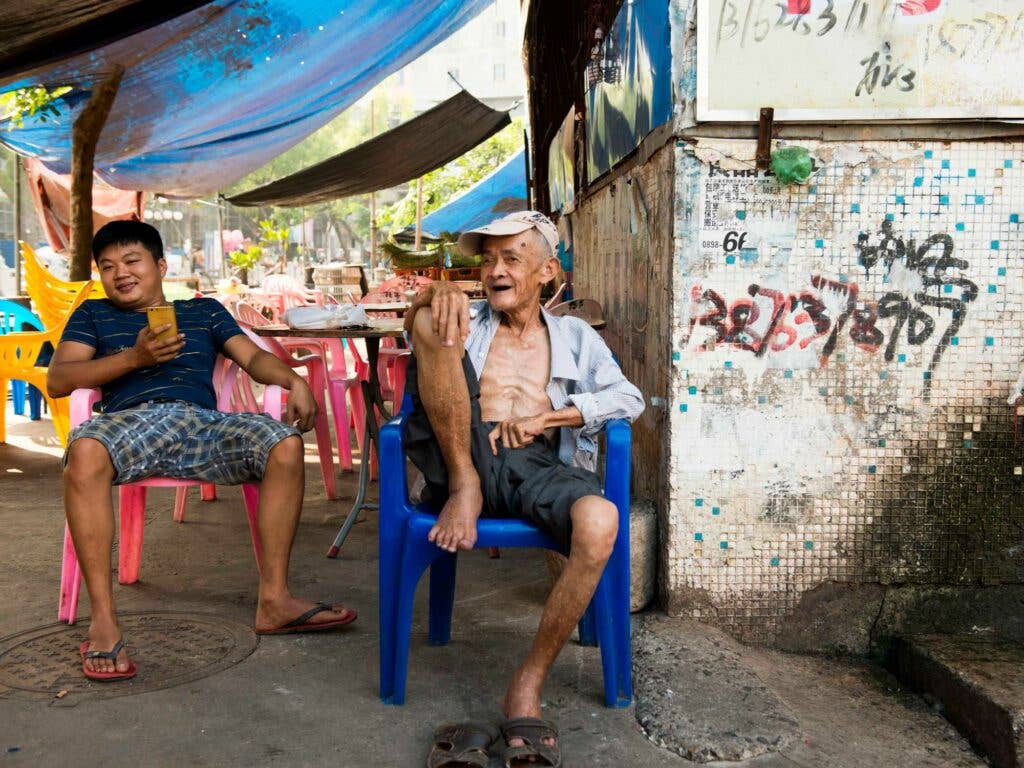
Goofy human-sized chicken statues, with human hands and human shoes and dilated human pupils, stand watch over the entrance of the Longquan Wenchang Chicken Industrial Farm, a half hour outside Wenchang. A government bureaucrat accompanying me (the farm is not open to the public so I had to arrange my visit through official channels) hands over a glossy booklet, and on the first page is sheet music for a song about Wenchang chicken (not the one on YouTube sung by Wu Duo Dong—with the lyrics "Never miss Wenchang Chicken! Nice skin texture, with fragrant meat!"—but the other Wenchang chicken song, by Yang Ji Min).
As we walk, I see two-month-old chickens enjoying their lunch recess: coconut flesh, rice, peanut cake, and Chinese yam, which they'll eat until they hit their final full weight of around three pounds. (American broilers are a comparative four pounds-plus.)
As we sit down for lunch at the Longquan farm restaurant, the plate of splayed chicken before me illustrates a critical difference between Western and Chinese tastes. For the Chinese, texture is as important a consideration as flavor. It explains the market for jellyfish, shark's fin, and bird's nest—foods with little taste, but with an in-mouth slip-and-slide quality that many Westerners find off-putting. The Chinese also tend to prefer meats with bony shards embedded. As a child of Hong Kong, I can speak for the tactile joys of chewing on a piece of crudely hacked, marrow-exposed chicken, slurping out juices, then using only my mouth to maneuver and extract the denuded bones. Wenchang chicken checks off those boxes.
Back in the farm's kitchen, cooks insist Wenchang chicken must be prepared with a loving touch. Rather than drop the carcass into the pot in one fell swoop, the bird is dipped in and out of the water several times before full submersion—like testing a hot tub with a single toe to get acclimated.
Poaching is only step one of the process. I watch as a chef takes pieces of cooked chicken, insulated with a quarter-inch layer of fat, and stir-fries them in peanut oil and dark soy. The skin somehow manages to pull in the tastes of sweet molasses and soy while morphing in texture from tender to sturdily crisp. Yes, this fried version also counts as Wenchang chicken. And it would knock the socks off any goofy cartoon chicken statue.
One night a few days later, I head to Education Road, where students from several nearby schools converge and every conceivable food cart caters to their thrifty needs at all hours of night. There's Bao Luo noodles, a soupy mélange of pork slices, peanuts, and beef jerky over rice noodles. Curried fish balls and sausages appear on sticks, and indeed, whole Wenchang chickens hang from meat hooks.
I find several ladies hunching over the sidewalk outside a restaurant. They are tending to a wok filled with a mountain of salt cooking over a low charcoal flame. Passersby gawk—it's a shrewd business decision. With archeological precision, these ladies proceed to excavate whole chickens buried within the salt mound.
Chen Ji Ying is the 65-year-old proprietor of Ji Ying Salt Baked Chicken. She greets me holding a stack of 100-yuan bills like she's starring in a hip-hop video. Chen, I'm told by students here, is quite the figure within Wenchang chicken lore. For the past 16 years, rather than using the poach-and-sauce method most other restaurateurs employ, she's been baking her birds in salt, to rave reviews from happy customers. I'm told at least a dozen other Wenchang salt-baked-chicken restaurants exist on the island.
I sit down for dinner. Then out come the plastic gloves. Put them on, Chen motions to me and my table mates. She places the bird in the center of the table. This is a serious development. Without communicating a word, she's saying, have at it.
Four pairs of hands simultaneously attack, Hungry Hungry Hippos-style, tearing into hot chicken skin and flesh. I return with a tender shard of meat slippery with chicken fat. I taste it. There is no dipping sauce. This doesn't need dipping sauce.
After many renditions of Wenchang chicken on Hainan, and a lifetime of eating poultry before that, this single salt-baked bite hits the reset button. It's meltingly rich and pushes the boundaries of savoriness. Guttural noises tumble out. Chicken has never tasted more of itself. Julia Child, Colonel Sanders, and a legion of bar kitchens in Buffalo found success on some level, but as I swallow my first bite, I'm convinced that only on Hainan Island do chickens become the best possible version of themselves.
Get the recipe for Wenchang Chicken and Rice with Calamansi Dipping Sauce
Get the recipe for Salt-Baked Chicken with Congee and Pickled Mustard Greens
Get the recipe for Rice Noodle Soup with Pork and Pickled Bamboo
Get the recipe for Rice Cakes Stuffed with Coconut and Brown Sugar (Yi Bua)
Keep Reading
Continue to Next Story










